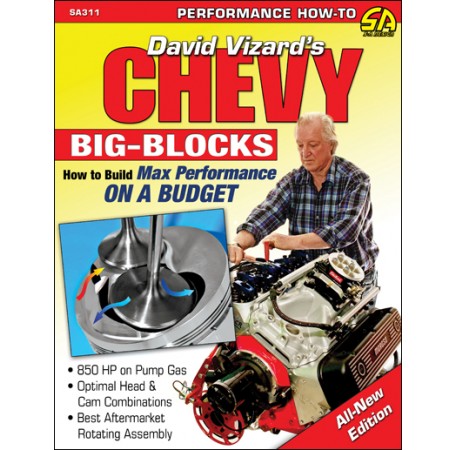Chevy Big-Blocks: Build Low-Cost Max Performance 454 427 396 Manual Book SA311
$23.95 WASItem# CARTECH-SA311
Weight: 1 lbs.
Publisher: CarTech, Inc
Softcover: 176 pages
Dimensions: 11.0 x 8.5 x 0.3 inches
FREE SHIPPING ON ORDERS $200+
The Chevy big-block has been installed in millions of cars and trucks over the past 50 years, including Camaros, Chevelles, Corvettes, Impalas, and a multitude of trucks. Extracting maximum performance has been the pursuit of engine builders ever since this engine was new in 1964.
As a follow-up title to his How to Build Max-Performance Chevy Big-Blocks on a Budget, master engine builder David Vizard takes big-block Chevy engine building to the next level and shows how to build these extreme high-performance engines without breaking the bank. It goes well beyond basic performance techniques and delves into exceptional detail on each component group of the engine. Vizard shows you how to build the ultimate big-blocks for the street: engines that are up to 850 hp on 91-octane pump gas, which is a monumental achievement.
The Chevy big-block has been substantially under-valved, and the key to getting the best performance from this engine is to deal effectively with this design limitation. Vizard explains how to minimize intake-valve shrouding, reveals the science behind all cam-timing events, and explains how to arrive at the correct valve overlap for maximum efficiency. Vizard also covers the nuances of piston ports, rings, and connecting rods so that the rotating assembly is strong and working at its peak. Finally, a special section presents a number of max-performance big-block sample builds.
This volume includes a huge range of cutting-edge aftermarket parts and advanced tuning techniques. If you're serious about building a max-performance Chevy big-block engine for the street or track, you owe it to your engine and yourself to include this book in your automotive library.
Chapter 1:
Displacement Decisions
Bores and Flow Anomalies
Minimizing Intake Shrouding
Bore Offset Power
Piston Wrist Pin Offset Potential
Modifications to the Bottom of the Bores
Bore Finishes
Modifications to the Lubrication System
Head Bolts and Studs
Strokers and Crank Clearances
Tall-Deck Blocks
Aftermarket Blocks for Big Inches
Aluminum Blocks
Other Critical Dimensions
Lifter Bores and Flat Followers
Lifter Bores and Roller Followers
Chapter 2:
Pistons, Connecting Rods and Crankshafts
Piston Porting
Dome Development
Gas Ports
Piston Rings
Connecting Rods
Crankshafts
Crank Dampeners
Chapter 3:
Lubrication Systems
Oil Pump
Block Modifications
Crankcase Vacuum
Oil Pans
Chapter 4:
Cylinder Heads
Port Shape and Volume
Flow Curves
Production Heads
Aftermarket Iron Heads
Aluminum Head Sources
Chapter 5:
Intake Manifolds
Single- and Dual-Plane Intakes
Rectangular-Port 4150 Intakes
Dominator Intakes
Options by Manufacturer
Chapter 6:
Single-Carb Induction
Brake Specific Air Consumption
True Street Carburation
Using What You Have
Mechanical or Vacuum?
High-Flow 4150-Style Carbs
Carb Flow Capability
Spacers
Dominator Tips
Chapter 7:
Tunnel Ram Intake Manifolds
Power Attributes
Dyno Test
Race-Only Applications
Chapter 8:
Electronic Fuel Injection
Carbs versus EFI
EFI System Variations
Port Injection
Chapter 9:
Camshafts and Valvetrain Events
A Few Basics
The Importance of Overlap
LCA Selection
Flow Figures
LCA Compression Correction
Optimal LCA
Wide LCA Syndrome
Cam Timing Precision
Chapter 10:
Valvetrain Optimization
Cam and Valve Lift
Cam Factors
Rockers and Ratios
Ratio Analysis
Pushrods
Stud Girdles or Shaft Rockers
Rocker Arms
Valvesprings
Retainers
Valve Weight
Cam Master Program
Chapter 11:
Ignition Systems
Advance Curve
Spark Power
Plasma Ignition
Crank Triggers
Chapter 12:
Exhaust Systems
Primary Lengths
Collectors
Evacupan Fittings
Chapter 13:
Chevy Big-Block Builds
Build 1: Edelbrock E-Street
Build 2: Entry-Level 496
Build 3: 482 Revisited
Build 4: UNO 525
Build 5: AFR 510
Build 6: AFR 572
Build 7: 496 EFI
Build 8: Pro-Filer Oval-Port 87-Octane
Build 9: 712 with Pro-Filer 12-Degree Heads
Specifications:
Pages: 144
Size: 8.5 X 11 (inches)
Format: Paperback
Illustrations: 367 color
Publisher: CarTech
ISBN: 9781613251621
Product Code: SA311


 Cart
Cart


